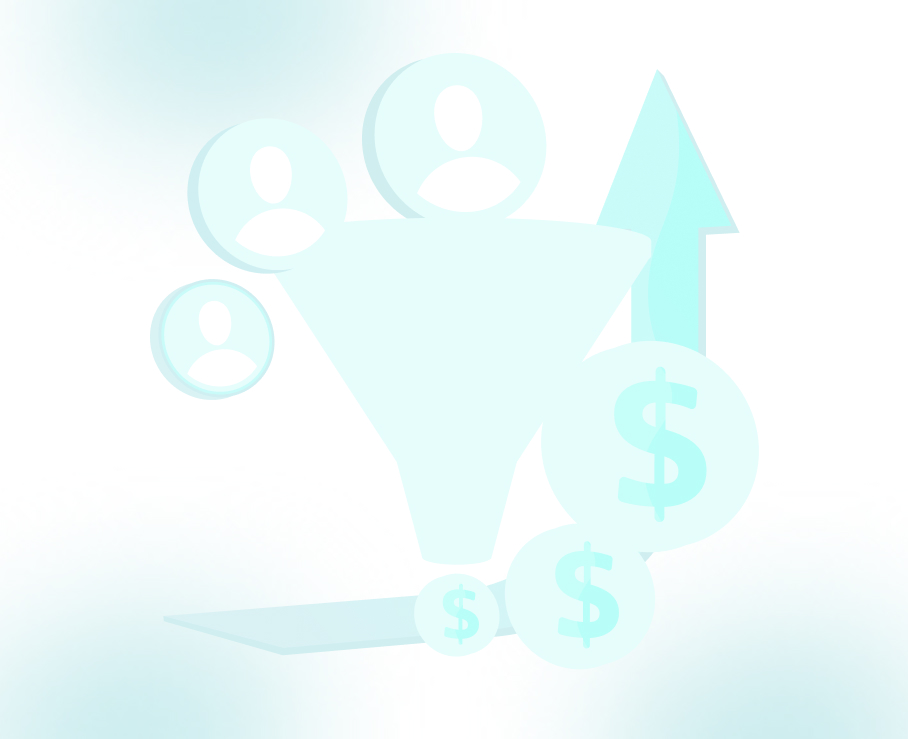
Difference Between Inside Sales and Outside Sales

Sales isn’t one-size-fits-all. Depending on your product, target market, and sales cycle, the way you sell can vary dramatically. That’s where the distinction between inside sales and outside sales becomes crucial. These two models represent fundamentally different approaches to reaching and converting customers, each with its own workflows, tools, strengths, and trade-offs.
In this blog, we’ll break down the difference between inside sales and B2B outside sales, not just in theory, but in how they work in real-world sales teams. Whether you’re structuring your team, evaluating performance, or choosing the right approach for a new market, understanding these differences can help you make smarter decisions and close more deals.
Key Takeaways:
- Inside sales involves remote selling through phone, email, and video, ideal for high-volume, lower-ticket, and SaaS or service-based businesses.
- Outside sales focuses on in-person meetings and is better suited for high-value, complex deals requiring deeper client engagement.
- Cost and scale: Inside sales is more cost-effective and easier to scale. Outside sales demands a higher investment but offers a stronger rapport for complex sales.
- Team structure: Inside sales reps manage more accounts; outside reps handle fewer, larger opportunities.
- Measurement: Each model needs different KPIs, inside sales leans on volume and velocity; outside sales tracks depth and deal size.
- Best-fit model: For most modern B2B teams, especially early-stage or resource-conscious ones, inside sales offers the flexibility, visibility, and momentum needed to grow.
What Is Inside Sales?
Inside sales refers to the practice of selling products or services remotely, without the need for in-person meetings. It relies heavily on digital tools such as email, video conferencing, and online platforms to connect with, nurture, and convert leads.
Unlike traditional field sales, which involves traveling to meet clients, inside sales reps operate from a fixed location, typically an office or home setup. This model has become increasingly dominant in B2B environments, particularly in sectors like SaaS, fintech, and IT services, where product interactions and decision-making processes are already digitally driven.
Read: How to Increase Sales When Business Is Slow: 7 Proven B2B Strategies
How Inside Sales Works: Key Stages in the Sales Process
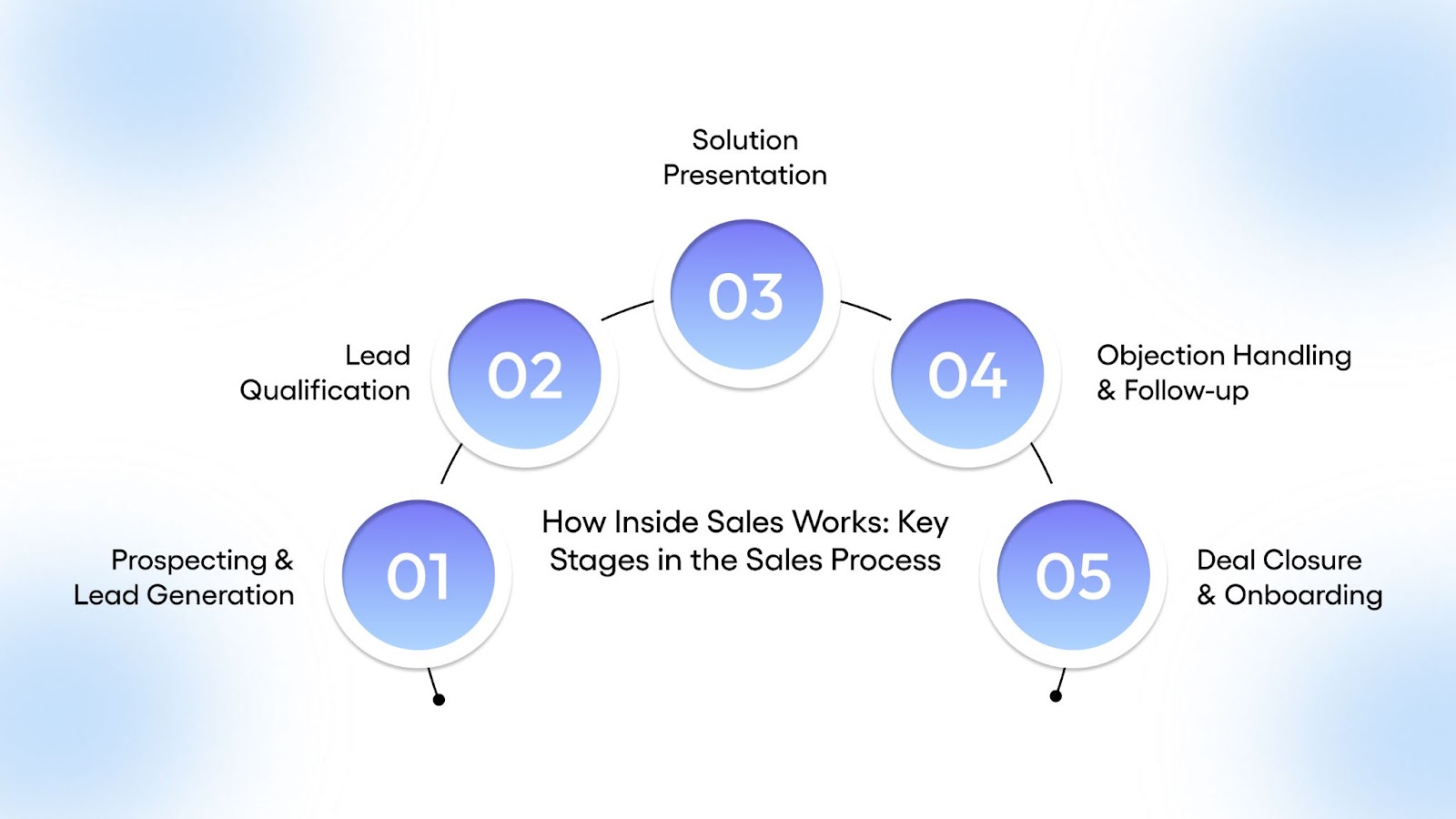
A well-functioning inside sales process is structured, technology-enabled, and repeatable. It usually follows these key steps:
- Prospecting and Lead Generation: Sales reps identify potential buyers through inbound sources (website forms, content marketing, referrals) or outbound outreach (cold emails, calls, LinkedIn messages).
- Lead Qualification: Reps evaluate whether a prospect meets criteria such as budget, authority, need, and timeline (often using frameworks like BANT or CHAMP). The goal is to focus only on genuinely sales-ready leads.
- Solution Presentation: This often takes the form of virtual product demos, tailored walkthroughs, or consultations delivered via screen sharing or video calls.
- Objection Handling and Follow-up: Sales reps address concerns, offer clarifications, and build confidence in the solution through ongoing digital touchpoints.
- Deal Closure and Onboarding: Final negotiations, contract signing, and customer onboarding happen through e-signature platforms and collaboration tools, making the end-to-end experience seamless and trackable.
Because inside sales is supported by automation and digital workflows, the sales cycle tends to be shorter and more focused, especially for lower-to-mid-ticket deals.
Why Inside Sales Works: Core Benefits
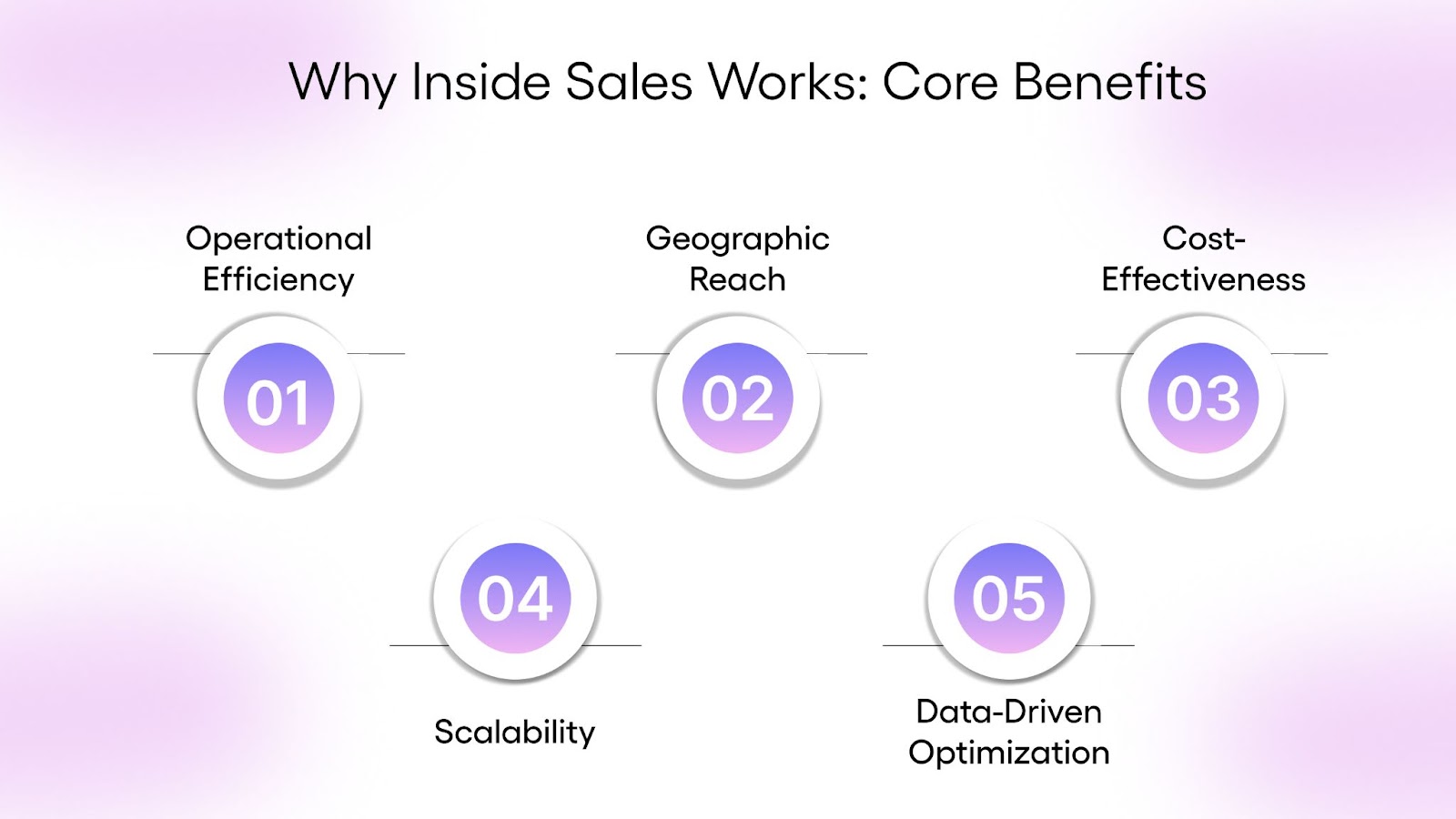
- Operational Efficiency: Without travel time or location constraints, reps can spend more hours in direct selling activities each day.
- Geographic Reach: Teams can access a broader market across regions or even countries, without the need for physical presence.
- Cost-Effectiveness: Reduced overheads (no travel, lodging, or event costs) make it easier to allocate resources to tools, training, or expanding the sales team.
- Scalability: Inside sales models are easier to replicate and scale. A strong playbook and tech stack allow for faster onboarding and predictable performance tracking.
- Data-Driven Optimization: Every interaction, from email opens to demo attendance, can be tracked and analyzed to refine messaging and improve conversions over time.
Considerations When Adopting an Inside Sales Model
While inside sales is highly effective for many businesses, especially in digital-first industries, it does come with nuances worth considering:
- Relationship Building Takes a Different Form: Building rapport virtually requires intentionality. Without physical cues, reps need to rely more on tone, timing, and personalization.
- Trust Can Take Longer to Establish: In high-stakes or high-touch industries, some buyers may prefer face-to-face interactions to build confidence in the brand or solution.
That said, with the right training and toolset, these challenges are manageable and often outweighed by the agility and reach that inside sales enables. It’s exactly why TLM leans into this model ourselves: combining deep product understanding with disciplined, personalized outreach that’s built to scale without losing human nuance.
What Is Outside Sales?
Outside sales, also known as field sales, is the practice of selling products or services through direct, in-person engagement. Unlike remote or virtual models, outside sales reps meet with prospects and clients face-to-face, often at offices, job sites, trade shows, or industry events. The role requires the ability to navigate real-world environments, read context quickly, and guide buyers through extended and often complex decision-making processes.
Outside sales is particularly common in industries such as manufacturing, real estate, healthcare, industrial equipment, and enterprise technology, where purchase decisions tend to be high-value, involve multiple stakeholders, and require in-depth consultation or live demonstrations. In many of these cases, the sales process is business-to-business, with a focus not just on selling a product but on aligning with operational needs, timelines, and organizational priorities.
Read: Understanding Lead Marketing: A Comprehensive Guide
How the Outside Sales Process Works
The outside sales process is typically more strategic and relationship-driven. It unfolds in stages:
- Initial Outreach: Reps might begin with leads generated through referrals, events, or a sales development team. Unlike inside sales, these conversations aim to set up in-person engagements rather than virtual demos.
- Meeting and Discovery: The rep meets the prospect at their workplace, a neutral location, or a trade show. This stage may involve walkthroughs, site assessments, or technical demonstrations, tailored to the customer’s unique environment.
- Relationship Building: Follow-ups often happen through a mix of calls, additional visits, or even informal interactions over lunch. These touchpoints allow reps to deepen rapport and uncover unspoken needs.
- Closing and Negotiation: Final discussions, pricing negotiations, and contract sign-offs are typically done in person, sometimes across multiple meetings.
Compared to inside sales, the cycle is longer, more resource-intensive, and demands sustained engagement over time.
Benefits of Outside Sales
- Higher Trust and Personalization: Physical presence fosters stronger connections. Reps can read nonverbal cues, adapt in real time, and build rapport faster, especially useful in risk-averse or high-value industries.
- Effective for Complex Solutions: When a product needs hands-on demonstration, or when the decision requires internal buy-in from multiple stakeholders, being on-site adds clarity and credibility.
- Deeper Account Relationships: Reps are more likely to uncover expansion opportunities during informal chats or walk-throughs, something harder to replicate in virtual calls.
Challenges and Limitations
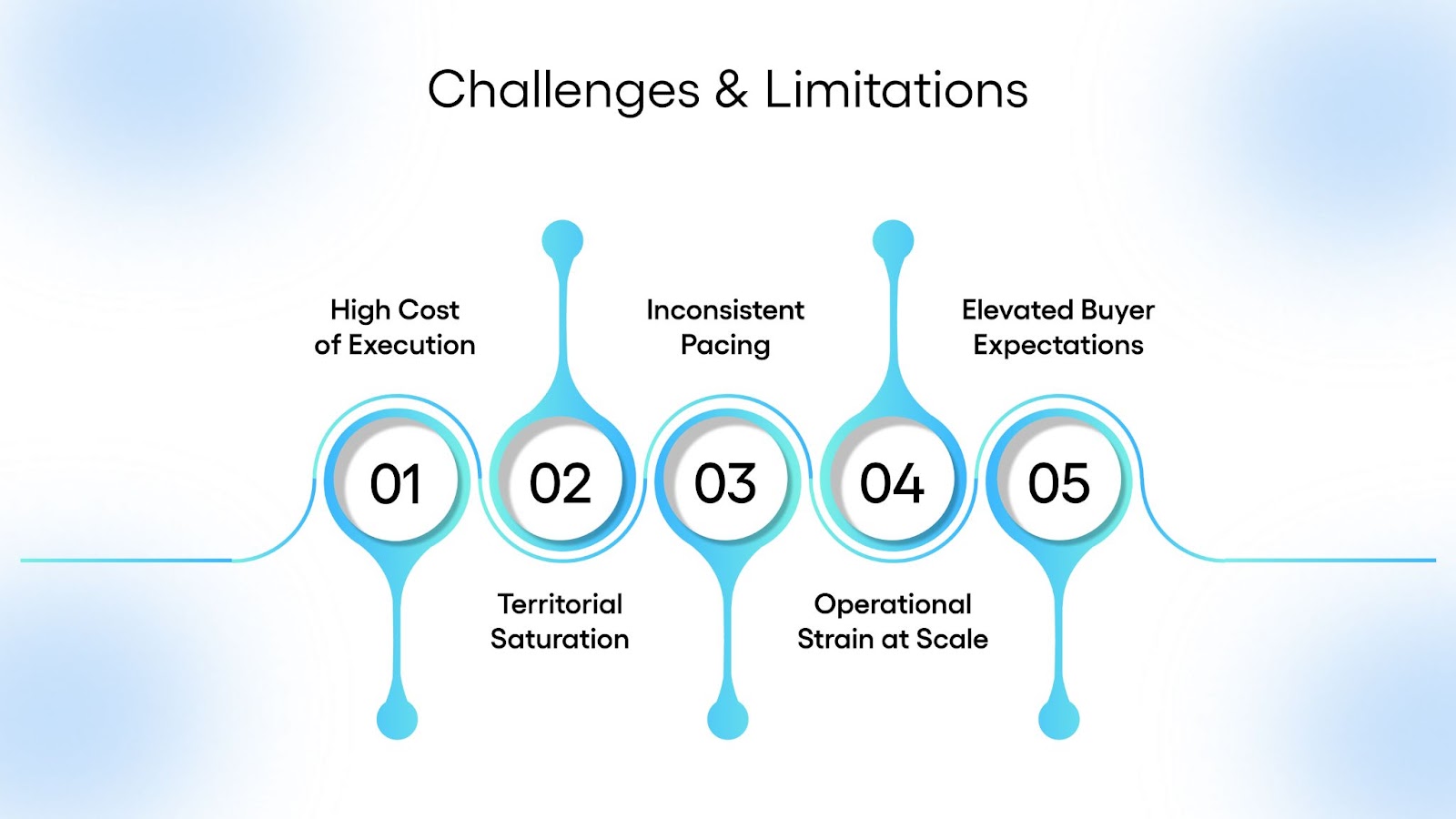
Field sales is effective, but not without friction. The model carries inherent trade-offs that impact cost, scale, and consistency.
- High Cost of Execution: Travel time, accommodations, and low daily meeting volume drive up the cost per interaction. When deals stall or fall through, sunk time and spend are harder to absorb than in remote models.
- Territorial Saturation: Reps are bound by geography. A field-based model limits weekly reach, and territory design must be precise to avoid gaps, overlap, or inefficiency across regional teams.
- Inconsistent Pacing: Face-to-face selling introduces scheduling friction. Gaps between meetings are common, especially when coordination involves multiple stakeholders across departments or sites.
- Operational Strain at Scale: Scaling outside sales requires more than headcount. Territory support, localized marketing, and logistical infrastructure become essential; without them, efficiency drops quickly.
- Elevated Buyer Expectations: An in-person meeting raises the bar. Clients expect insight, relevance, and preparedness. A weak interaction isn’t just ineffective—it can stall momentum in ways digital missteps often don’t.
Outside sales continues to be a powerful strategy for industries where relationship-building, physical presence, and solution complexity are central to the sale. While it’s less scalable than inside sales, it often delivers higher win rates and deeper customer loyalty in the right contexts.
For companies navigating hybrid buyer preferences, a thoughtful mix of inside and outside sales, aligned with customer needs and deal size, often yields the best results.
Read: Industries That Rely on Lead Generation Services
Inside vs. Outside Sales: What Really Sets Them Apart?
In a changing sales landscape, the way your team connects with prospects can shape everything from deal size to long-term customer relationships. The distinction between inside and outside sales goes beyond location or mode of communication; it reflects deeper differences in strategy, buyer engagement, and how sales processes are structured.
1. Engagement Channels: Digital-First vs. In-Person Relationship Building
Inside sales professionals operate remotely, using a suite of digital tools to connect with prospects and customers.
Channels include:
- Personalized email sequences.
- Phone calls and SMS outreach.
- Live chat platforms and messaging apps.
- Webinars and video conferencing.
- Social selling via platforms like LinkedIn.
Success in inside sales often comes from outstanding virtual engagement. Reps must master crafting compelling emails, hold engaging online demos, and make memorable impressions without ever meeting face-to-face. This model allows rapid multi-touch outreach and responsiveness, crucial in fast-paced industries or when targeting geographically scattered buyers.
In contrast, outside sales are characterized by physical presence:
- Face-to-face client meetings.
- Attend industry events, trade shows, and networking gatherings.
- In-person product demos or site visits.
- Building local connections and rapport over coffees or dinners.
While in-person engagement can foster deep connections and nuanced trust, it demands travel and a flexible schedule, limiting the number of meetings per day compared to digital touchpoints.
2. Cost Structure: Lean Scaling vs. High-Touch Investment
Inside sales offers a cost advantage in nearly every category:
- No travel expenses (flights, mileage, hotels).
- Minimal time lost to transit.
- Smaller physical infrastructure needs (home offices or shared spaces).
- More predictable scheduling and higher prospect volumes per rep.
This makes inside sales ideal for organizations focused on scaling revenue with limited resources, maximizing rep productivity, or targeting wide geographic regions. The cost-per-acquisition is typically lower, though success still relies on digital acumen and process optimization.
Outside sales, by contrast, naturally incur higher costs:
- Frequent travel (locally, regionally, or even globally).
- Entertainment expenditures for relationship-building (meals, events).
- Longer sales cycles and greater time invested per deal.
However, these investments may be justified when closing deals of significant size or complexity, where personal trust and thorough consultative engagement are decisive.
3. Interaction Dynamics: Virtual Persuasion vs. In-Person Adaptability
Inside sales requires reps to excel at virtual communication skills:
- Writing clear, persuasive emails and proposals.
- Actively listening during phone and video calls.
- Navigating digital objections and questions.
There is limited ability to read physical cues, so inside reps must recognize verbal signals, tone of voice, pauses, and engagement level, to adapt their approach instantly.
Outside sales professionals thrive on in-person rapport:
- Reading body language and subtle emotional signals.
- Adapting presentations on the fly based on the environment.
- Using real-time demonstrations and physical product handling.
- Building deep trust through personal gestures (handshakes, eye contact).
These skills are valued when nuance matters, especially in industries with complex decision cycles or where relationships are central to the sale.
4. Deal Complexity and Sales Cycle
Inside sales shines when handling:
- Standardized products/services.
- Lower average deal values.
- Short sales cycles and quick-turn engagements.
- High-volume, transactional sales environments (e.g., SaaS subscriptions, online marketplaces).
The ability to handle multiple deals concurrently, often automating parts of outreach and follow-up, makes inside sales the go-to strategy for efficiently managing routine or moderately complex transactions.
Outside sales is better suited for:
- Complex, high-value, or technical sales.
- Deals requiring deep discovery, custom solutions, and extended negotiation.
- Products/services that demand demonstration, on-site assessment, or solutions integration.
- Verticals where personal trust or multi-stakeholder consensus is essential (e.g., enterprise IT, capital equipment, real estate).
Here, personalized engagement and the ability to address unique buyer needs in real time can mean the difference between winning and losing a deal, even if the cost per pursuit is higher.
Each approach has distinct advantages rooted in the communication channel, cost profile, interaction style, and ideal deal complexity. Inside sales professionals deliver scalable, efficient growth by mastering digital engagement and process optimization. Outside sales, meanwhile, remains indispensable for organizations where human connection, intricate negotiation, and high-stakes deals are at the core of success. Choosing the right model, or blending both, depends on your business goals, products, and customer expectations.
Read: Understanding Outbound Sales: Strategies and Tips
Building an Integrated Sales Strategy That Works
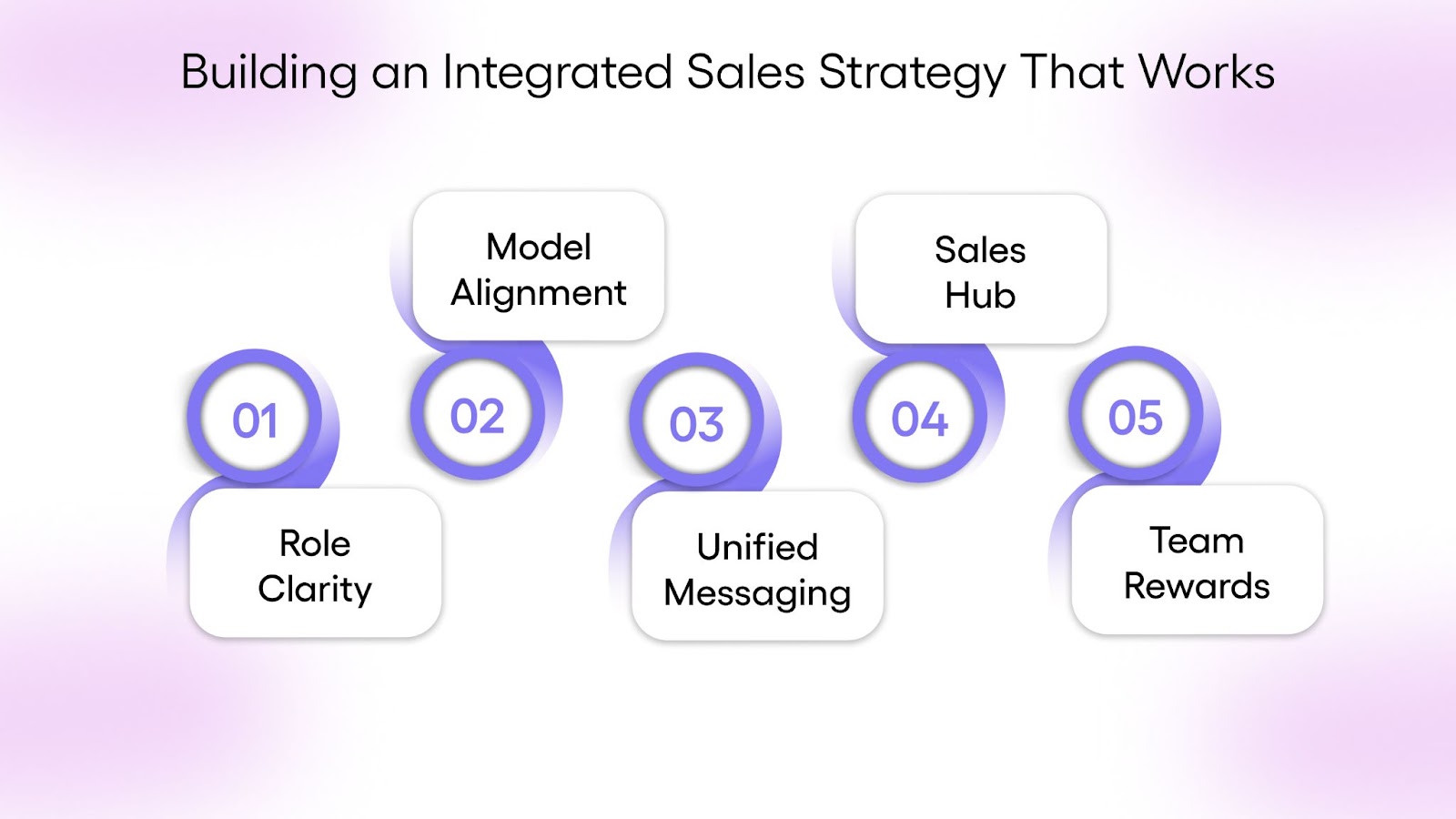
For B2B companies navigating complex buyer journeys, the debate isn’t “inside vs. outside sales” anymore. The most effective sales orgs build a coordinated model that leverages the speed and reach of inside sales while preserving the high-touch value of outside engagement, where it truly matters. Here’s how modern teams are making that balance work:
1. Define Distinct Roles, Then Identify Strategic Overlap
Inside and outside sales bring different strengths to the table. Inside reps are optimized for speed, scale, and digital-first engagement, perfect for early-stage outreach, qualification, and remote demos. Outside reps bring strategic depth and in-person rapport that’s valuable for high-risk or high-complexity deals.
The key is to design roles that are complementary, not competitive:
- Use inside sales to create initial momentum and build a qualified pipeline
- Bring in outside reps when stakeholder alignment, or complex buying committees demand face-to-face input
- Create shared ownership of the customer lifecycle, not just the lead handoff
2. Let Product and Buyer Dynamics Shape Your Model
Not every sales motion warrants boots on the ground. Today’s buyers, especially in SaaS, B2B services, and mid-market segments, are more open to digital-first sales cycles.
Consider these when deciding how to weigh inside vs. outside sales:
- Is your product demoable remotely? If yes, lean into inside sales
- Are most stakeholders digital natives? A high-velocity inside motion may be all you need
- Is trust built through process rather than presence? Some industries care more about consultative value than coffee meetings.
Let buyer behavior guide your allocation, not legacy assumptions.
3. Standardize Messaging to Reduce Friction and Build Trust
Whether a deal is closed virtually or in person, buyers should hear a consistent story from your brand. Inside and outside teams need to work from the same strategic narrative, not just scripts.
That means:
- Shared messaging frameworks tailored to segments and deal sizes
- Unified positioning of features, pricing, and customer outcomes
- Aligned approaches to discovery, value articulation, and follow-up
Consistency here doesn’t just prevent confusion, it helps accelerate decision-making.
4. Make Inside Sales the Core, Not Just a Support Role
Too often, inside sales is viewed as the junior partner in a hybrid setup. But when properly positioned, it becomes the engine of pipeline growth and the source of early momentum across the entire sales funnel.
Best-in-class orgs position inside sales to:
- Own the outbound strategy and experimentation
- Manage mid-market or volume-based accounts independently
- Pilot new markets or ICPs with lower investment risk
- Collect intel on buyer objections and trends to feed the upstream strategy
By giving inside reps autonomy and growth tracks, not just handoff duties, you retain talent and drive better cross-team outcomes.
5. Incentivize Collaboration Over Territory Competition
Hybrid sales fail when incentives pull reps in opposite directions. Instead of assigning value by geography or deal size alone, tie compensation to shared outcomes.
Some effective models include:
- Team-based bonuses tied to closed revenue, not just meetings or stages
- Joint accountability metrics (e.g., lead-to-close rate across both teams)
- A/B testing different reward structures by region, product line, or deal tier
The inside–outside debate isn’t about picking a winner; it’s about building the right mix for your market. When roles are clear, incentives aligned, and the buyer’s journey drives the design, your sales organization can move with both speed and precision.
Read: Understanding the Stages of a B2B Sales Funnel
Inside vs. Outside Sales: How to Track and Measure Performance
The way you measure sales performance should reflect how each role works. Inside and outside sales teams operate under different conditions, so their benchmarks and KPIs need to match those realities. Grouping them under the same set of metrics often leads to distorted evaluations and missed opportunities to improve. Here's how to break it down:
1. Start With the Right Baselines
Before comparing performance, normalize for context. Inside sales reps usually handle higher volume and shorter sales cycles. Outside reps deal with longer cycles, larger deal sizes, and often more stakeholders.
Track per-rep activity by role, not in aggregate. Use separate dashboards for each team. A rep who books 12 meetings per week remotely isn’t underperforming next to a field rep who does 2, if the latter is closing high-value enterprise deals.
2. Key Metrics for Inside Sales
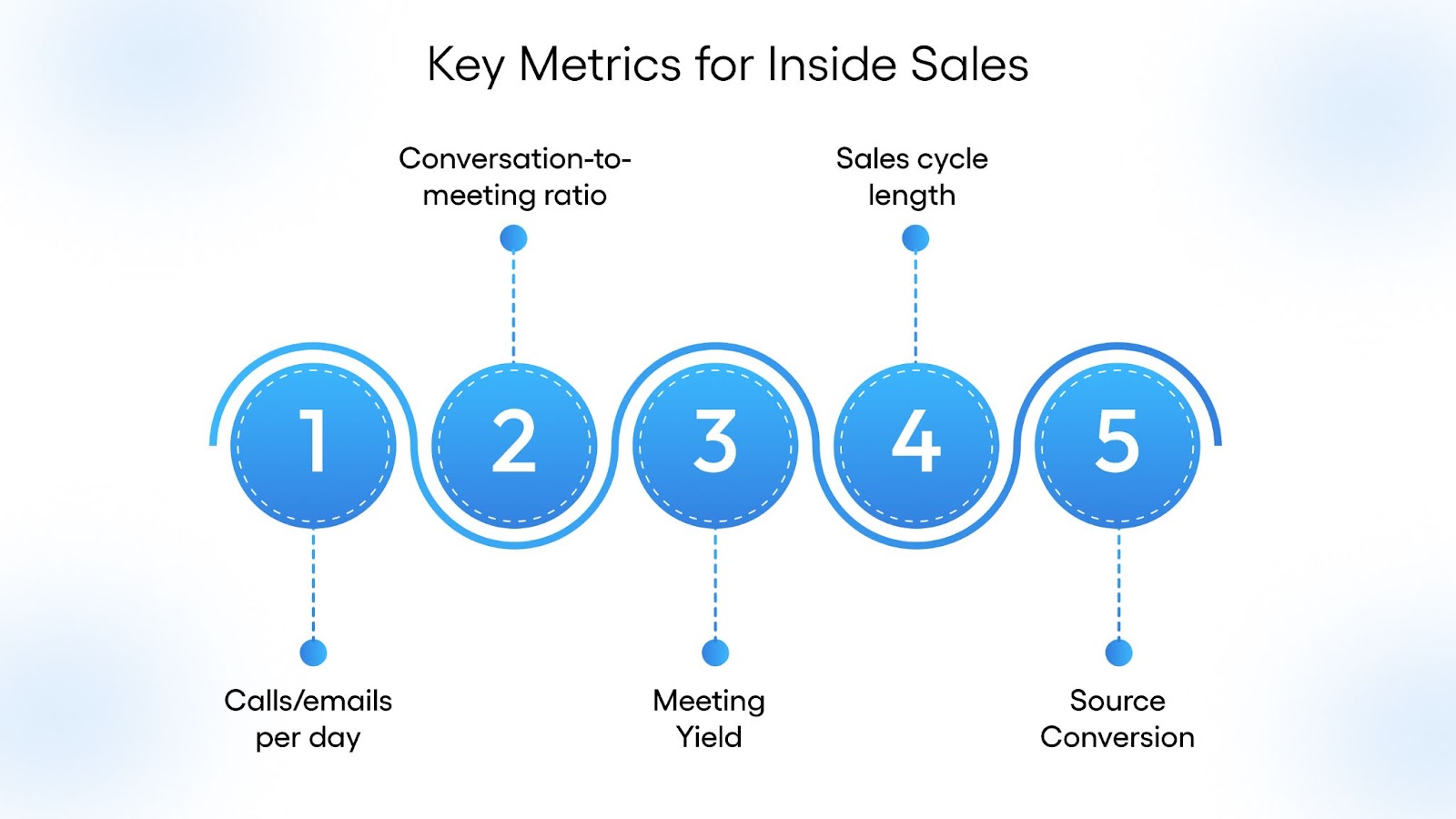
Inside sales relies heavily on speed, responsiveness, and volume-based efficiency. Prioritize:
- Calls/emails per day
Measures effort and pacing — useful when aligned with connect rates. - Conversation-to-meeting ratio
Focuses on the quality of outreach. If reps are calling 80 people and booking 1 meeting, your messaging or targeting may be off. - Meeting-to-opportunity conversion rate
Helps you understand if discovery calls are truly qualifying leads. - Sales cycle length (in days)
Shorter cycles usually point to better qualification and faster follow-up. - Close rate by lead source
Not all inbound leads are equal. Knowing what converts helps sharpen prioritization.
Read: How to Optimize Email Cadence for Better Results?
3. Key Metrics for Outside Sales
Outside sales is slower and relationship-driven, with fewer at-bats but bigger outcomes. Metrics should reflect that pacing:
- On-site meetings per month
In-person visits still matter. Track them, especially for enterprise segments. - Pipeline coverage ratio
(Total pipeline/quota). Healthy field reps often maintain 3x or higher to hit targets, given slower movement. - Win rate by segment or region
Shows where field strategies or positioning are most effective. - Average deal size
Tracks whether the rep is focused on strategic targets or falling into small-ticket habits. - Cycle stage duration
Helps isolate where deals are stalling — is it budget, legal, or internal approvals?
4. Qualitative Inputs Matter, Too
Don’t rely solely on CRM data. Shadow calls, join in-person meetings, and listen to how each team handles objections or frames value. For outside reps, especially, relationship quality and account penetration aren’t always visible in dashboards.
Run quarterly review sessions where inside and outside reps walk through recent deals, not just to measure performance, but to share approaches. What works in one channel can often inform the other.
Read: Targeted Lead Generation: Boost MRR with High-Intent Leads in 2025
5. Bridge Metrics for Shared Accountability
If both teams touch the same funnel, consider using shared metrics in addition to role-specific ones:
- Lead response time
- Hand-off success rate (lead → opportunity → close)
- Account engagement before/after meetings
These help align goals across the two sides and make handoffs smoother.
Tracking sales performance isn’t about choosing one method over another — it’s about measuring the right things for the way each team sells. Clean inputs, role-specific KPIs, and regular reviews give you not just clearer dashboards but a more effective revenue engine.
Read: How to Boost Your Sales Pipeline Effectively
Determining the right sales approach for your business: Should you use inside or outside sales?
There’s no universal answer to whether inside or outside sales is “better”—only what’s more aligned with how your customers buy and how your team can operate most efficiently. Each model comes with tradeoffs, and understanding them helps avoid costly missteps.
Outside sales—the traditional, face-to-face method—is still well-suited for high-stakes deals, long enterprise cycles, and industries where in-person relationship building is expected. It gives reps more room to tailor their pitch, navigate complex buying groups, and build trust over time. But it also brings higher costs, slower feedback loops, and limited scalability. Travel takes time. Meetings get rescheduled. And insight into deal progress often lags.
Inside sales, by contrast, happens remotely, by email, phone, video, or chat. It trades proximity for reach. Reps can handle more accounts, touch base more often, and move faster between pipeline stages. For software, SaaS, services, or any offering that doesn’t demand physical demos or site visits, this model usually delivers more efficiency without sacrificing deal quality.
What’s often overlooked is how much easier it is to measure and improve inside sales. Calls and emails can be tracked, sales behaviors analyzed, and results tied directly to outreach strategies. That data helps managers coach better and iterate faster, without needing to guess what’s working in the field.
A blended model may work for some, especially those selling across segments. But for many teams, especially early-stage or resource-conscious ones, starting with inside sales allows for speed, focus, and growth without the overhead of managing a traveling sales force.
Boost Your Sales with TLM
Inside sales delivers scale without added complexity, and TLM Inside Sales offers a focused, proven approach to make it work.
Our services include:
- Clear lead qualification rules, defined by you
- Consistent appointment-setting, not just outreach
- Transparent reporting with access to all campaign activity
- Dedicated follow-ups to move prospects through the pipeline
With TLM Inside Sales, you stay in control of the process while we handle the day-to-day execution. From building the right list to scheduling conversations that matter, everything is structured to support your internal sales team, not replace it. If you’re ready to strengthen your inside sales program with a team that works quietly in the background and keeps quality front and center, we’re ready to talk.
Wrapping Up
The choice between inside and outside sales isn’t a question of which is “better.” It’s about understanding how your buyers make decisions, what your product requires, and how your team is structured to deliver results.
For many B2B companies, especially in SaaS, IT, and service-based industries, inside sales offers the reach, speed, and data visibility needed to grow with focus. It’s measurable, replicable, and easier to scale without adding unnecessary overhead. That doesn’t mean outside sales is obsolete; there are still use cases where in-person engagement adds real value. But for teams balancing speed with precision, and scale with control, inside sales often becomes the more sustainable engine.
If you’re thinking about building or improving your inside sales motion and want a team that knows how to get the fundamentals right, TLM Inside Sales can help you get started.
FAQs
1. What is an example of inside sales?
Inside sales is the process of selling remotely, without face-to-face meetings. A common example is a sales rep using targeted email campaigns to engage B2B prospects. All communication, from outreach to follow-ups, happens over email, leading to scheduled sales appointments.
2. What is an example of outside sales?
Outside sales involves face-to-face interactions. A field sales rep visiting manufacturing companies to demonstrate industrial equipment and negotiate contracts on-site is a strong example. These deals are usually higher value, involve longer sales cycles, and require deeper relationship building with multiple decision-makers.
3. What is the difference between sales in and sales out?
“Sales in” typically refers to products sold into a business, like a distributor purchasing inventory from a supplier. “Sales out” refers to those products being sold from the distributor to the end customer.
4. Is B2B inside or outside sales?
B2B can involve both, but inside sales has become the more common approach, especially in industries like software, services, and IT. Many B2B companies rely on inside sales teams to drive outreach, demos, and deal closure entirely through digital channels.





